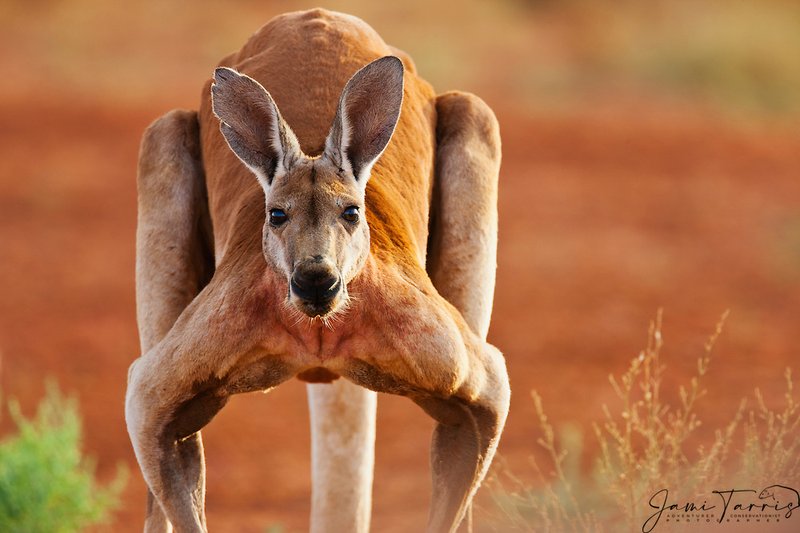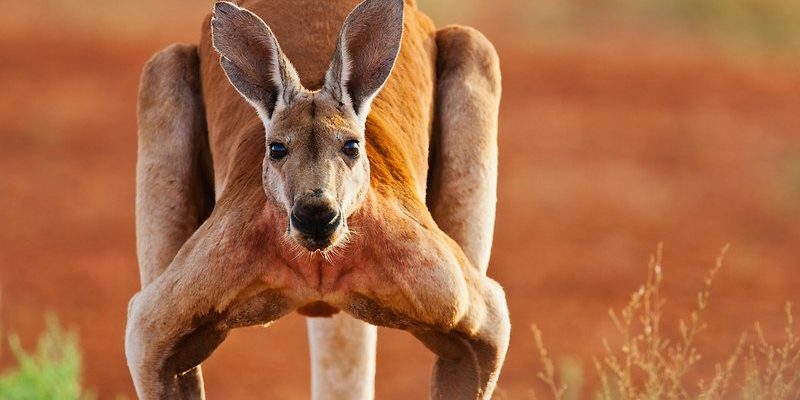
The Red Kangaroo is not just any ordinary animal; it’s a symbol of Australia, often embodying the spirit of the wild Outback. When you think of kangaroos, the image that likely jumps to mind is that of these powerful, hopping creatures bounding across the red desert sand, their tails balancing them like a tightrope walker. These fascinating marsupials are truly iconic in every sense, standing tall in both stature and cultural significance.
But what really makes the Red Kangaroo stand out? It’s not only their impressive size—being the largest of all kangaroo species—but also their unique adaptations to survive in some of the harshest environments on Earth. From their massive hind legs that can propel them over long distances to their remarkable ability to conserve water, Red Kangaroos are engineering marvels of nature. So, let’s hop right into the world of these extraordinary animals and uncover what makes them so special!
Physical Characteristics of Red Kangaroo
The Red Kangaroo is easily recognizable with its distinctive features. Adult males can reach heights of up to 8 feet when they stand on their hind legs, with a body that can weigh between 120 to 200 pounds. Their fur is a beautiful reddish-brown color, which serves as excellent camouflage against the arid Australian landscape. Their long legs are not just for show; they enable them to leap great distances—up to 30 feet in a single bound, which is about the length of a school bus!
Interestingly, females are smaller than males, standing about 5 to 6 feet tall and weighing significantly less. They have a more greyish-brown coat, which helps them blend into their surroundings, particularly in the shaded areas of the bushland. Both genders possess powerful tails that help with balance while hopping and when standing still. This unique body structure helps them thrive in their natural habitat while showcasing their incredible strength and agility.
One of the most fascinating aspects of the Red Kangaroo’s anatomy is their large feet. Designed for efficiency, these feet allow them to travel long distances in search of food and water. They have a special adaptation in their legs that allows them to store energy effectively. In a way, you could think of their legs as giant springs, coiling and releasing energy with each powerful jump.
Habitat and Distribution
Red Kangaroos are primarily found in the vast arid regions of Australia, particularly in the Outback. They prefer open grasslands, scrublands, and semi-desert environments, where they can roam freely in search of food. Interestingly, these kangaroos have adapted remarkably well to the harsh conditions of the Australian interior. They can live in areas with very little water, relying on their keen sense of smell to locate water sources from afar.
Although Red Kangaroos are predominantly found in the wild, some populations have adapted to living closer to human settlements. This adaptability can sometimes lead to conflicts with farmers, as kangaroos may invade crops looking for food. However, it’s essential to remember that these animals are simply trying to survive in a changing environment. Their resilience and ability to find suitable habitats highlight their important role in the ecosystem.
As climate change impacts Australia’s landscapes, Red Kangaroos may have to adapt even further. It’s fascinating to consider how they might evolve, just as they have in the past, to cope with changes in their environment. Understanding their habitat needs is vital for conservation efforts aimed at preserving this iconic species for future generations.
Diet and Feeding Habits
Red Kangaroos are herbivores, primarily feeding on a variety of grasses, leaves, and shrubs. They are well-suited for grazing, and their digestive systems are adapted to process tough, fibrous plant material efficiently. Interestingly, these kangaroos can consume a wide range of vegetation, even eating plants that are low in moisture content, which helps them thrive in arid regions—quite impressively, their bodies can extract moisture from the food they consume.
During the hottest part of the day, Red Kangaroos often seek shade to avoid overheating. They will typically venture out during the cooler hours of dawn and dusk to feed, which minimizes their exposure to the sun. You might be wondering how they manage to find enough food in such a sparse environment. Their keen eyesight and strong sense of smell come in handy when searching for vegetation. Plus, they are known to migrate in search of better feeding grounds, which showcases their adaptability.
Another fascinating aspect of their feeding behavior is how they interact with their environment. When grazing on grasslands, Red Kangaroos can help to maintain the ecosystem’s health by promoting grass growth. Their feeding patterns can prevent certain plants from overgrowing, allowing a diverse range of species to thrive in their habitat. It’s like they are nature’s lawnmowers, playing a significant role in maintaining biodiversity.
Reproductive Behavior
Reproduction in Red Kangaroos is as fascinating as their physical characteristics. The mating season typically occurs during the warmer months, and males will engage in displays of strength to attract females. This often involves boxing matches, where two males will spar using their powerful legs and tails. These displays not only show off their strength but also serve as a way to establish dominance, helping females choose the fittest mates.
Once a female is ready to mate, she can give birth to a single joey after a gestation period of about 30 to 36 days. This tiny, underdeveloped joey then crawls into its mother’s pouch, where it continues to grow and develop for several months. It’s quite a sight to see these little ones peeking out, often their heads just visible above the edge of the pouch as they cling to their mother for safety while learning about the world around them.
Interestingly, Red Kangaroos have a unique reproductive strategy called embryonic diapause. This means that if conditions are not favorable for raising a joey—like during droughts or food shortages—a female can delay the development of a fertilized egg. This fascinating adaptation allows them to time their reproduction with the environment, ensuring the highest chance of survival for their young.
Conservation Status
The conservation status of the Red Kangaroo is classified as “Least Concern,” according to the IUCN Red List. This classification means that, while they face some threats, their populations are generally stable. However, it’s important to note that they are still vulnerable to habitat loss, climate change, and hunting pressures. As human activities continue to impact their natural habitats, conservation efforts are essential to ensure their long-term survival.
Many organizations are working tirelessly to protect these iconic creatures and their habitats. Efforts include the establishment of protected areas, education programs to raise awareness about their role in the ecosystem, and initiatives to promote sustainable land use practices among local communities. By engaging communities and promoting responsible tourism, we can help safeguard the future of the Red Kangaroo.
Ultimately, protecting the Red Kangaroo also means safeguarding the unique ecosystems they inhabit. As a keystone species, their presence is vital for maintaining the delicate balance of the grasslands and scrublands they call home. Supporting conservation initiatives is one way we can all contribute to ensuring these magnificent animals continue to thrive for generations to come.
Interesting Facts about Red Kangaroo
| Size: | Adult males can weigh up to 200 pounds and stand 8 feet tall. |
| Habitat: | Open grasslands, scrublands, and arid regions of Australia. |
| Diet: | Primarily herbivorous, feeding on grasses, leaves, and shrubs. |
| Speed: | Can leap up to 30 feet and cover about 35 miles per hour. |
| Lifespan: | 15 to 20 years in the wild. |
FAQ
What do Red Kangaroos eat?
Red Kangaroos are herbivores that primarily graze on grasses, leaves, and the occasional shrub. Their diet is quite flexible, allowing them to consume a variety of vegetation, even in arid environments. They can extract moisture from their food, which is essential for survival in their dry habitats.
How fast can a Red Kangaroo move?
These impressive animals can reach speeds of up to 35 miles per hour while hopping. Their powerful legs allow them to cover significant distances in one leap, making them one of the fastest animals in their environment. They can also leap over impressive distances—up to 30 feet—making their agility a key factor in evading predators.
How do Red Kangaroos adapt to their environment?
Red Kangaroos have several adaptations that help them survive in harsh conditions. They can conserve water efficiently, have strong legs for long-distance travel, and can forage for food even in sparse environments. Their ability to go without water for extended periods showcases their remarkable resilience.
What is the lifespan of a Red Kangaroo?
In the wild, Red Kangaroos typically have a lifespan of around 15 to 20 years. However, those in captivity may live longer due to the absence of predators and access to consistent food and care.
How do Red Kangaroos communicate?
Red Kangaroos communicate using a range of vocalizations, body movements, and even facial expressions. They can make distinct sounds such as grunts, coughs, and sometimes even use low-frequency calls that can be heard over long distances.
Are Red Kangaroos social animals?
Yes! Red Kangaroos are social creatures that often gather in groups called “mobs.” These mobs provide safety in numbers, helping protect individuals from predators. Social interactions within the mob help strengthen bonds, particularly between mothers and their joeys.
Can Red Kangaroos be kept as pets?
While they are fascinating animals, it is not advisable to keep Red Kangaroos as pets. They require large spaces to roam and specific diets, which can be challenging to replicate in a home environment. Additionally, they are wild animals and may become stressed in captivity.
What threats do Red Kangaroos face?
Red Kangaroos face several threats, including habitat loss due to urban development and agricultural expansion, climate change, and hunting. It’s crucial to engage in conservation efforts that protect their natural habitats and raise awareness about their importance in the ecosystem.
How do Red Kangaroos care for their young?
Mother Red Kangaroos care for their joeys by keeping them safe in their pouch, where they continue to develop and grow. After several months, the joey will start to venture out, but it will return to the pouch for safety and nourishment as needed during the early stages of its life.
What role do Red Kangaroos play in their ecosystem?
Red Kangaroos are considered a keystone species in their ecosystems. By grazing on grasses, they help maintain vegetation diversity and promote healthy growth. Their presence supports a balanced ecosystem, making them vital to the health of their habitats.

